Sports
Practical ideas for young high jumpers, athletes, parents, teachers and coaches
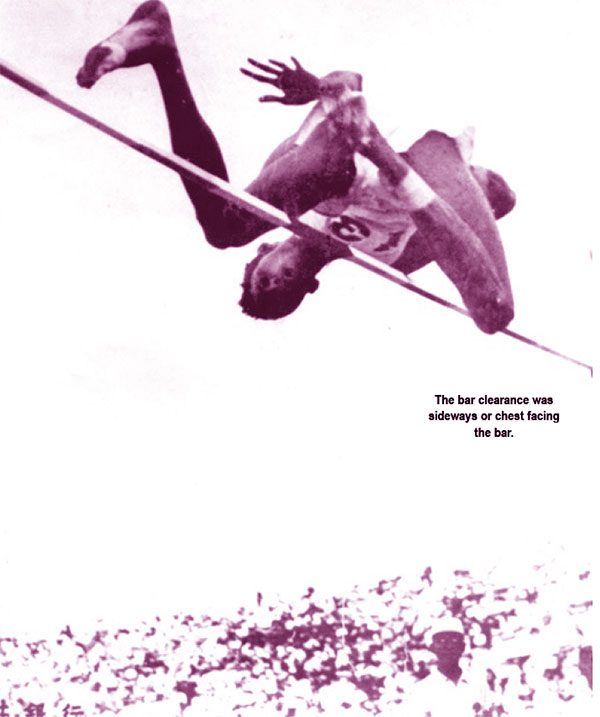
An Olympian writes
by Nagalingam Ethirveerasingam
In villages and urban areas in Sri Lanka children play softball cricket, soccer, running and jumping after school, weekends and during end-of-term holidays. This article is based on my experience from 1943. Children can use space available in areas near their houses or in space available around their house. Children are creative, to plan, execute and resolve their problems and learn from their errors.
It is important for children to actively take part in sports with whatever facilities available. If none are available to make them, they can play indigenous games that uses legs, hands, running, jumping, balls, seeds, marbles to create strategies, problem solving and decision making, and learn social and sportsmanship skills. In all games the participants will learn to abide by the rules and decision made by the Referee or Umpire.
In athletics, we dug high jump and pole vault pits. We loosened the soil with a spade. The high jump and pole vault posts were two thick straight branches from the Poovarasu tree planted permanently with nails driven two inches apart. The bar was a one-inch thick branch of the same tree. The pole was a straight branch thicker than the cross bar.
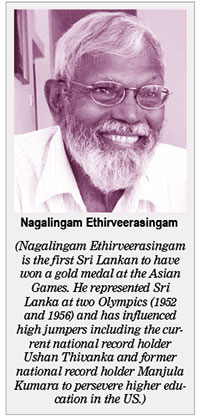 At school, the high jump, long jump, triple jump and pole vault pits were filled with sand. The pole vault standards were made of wood with a base. It had a movable part inside the main post that can be raised to 12 or 13 ft. For high jump the same posts or posts 6’ 6″ with a base is used. All wooden posts were made by carpenters in Jaffna adopting design in sports books or modeled after the posts in schools in Colombo. The poles were bamboo of different length and thickness. They were cured in fire made from dry leaves to strengthen them.
At school, the high jump, long jump, triple jump and pole vault pits were filled with sand. The pole vault standards were made of wood with a base. It had a movable part inside the main post that can be raised to 12 or 13 ft. For high jump the same posts or posts 6’ 6″ with a base is used. All wooden posts were made by carpenters in Jaffna adopting design in sports books or modeled after the posts in schools in Colombo. The poles were bamboo of different length and thickness. They were cured in fire made from dry leaves to strengthen them.
The loosened soil or sand in the jumping pit dictated we land in one or both feet in the high jump or pole vault. The bar clearance was sideways or chest facing the bar. In the high jump most used the scissors style and land in one or both feet. Older jumpers used Eastern Cut Off. In that style they ran from the front of the bar, made a curve going outside one of the posts and took off with one foot.
In 1948 we read in the papers the results of the athletic events. We saw the pictures of events. We saw Harrison Dillard won the 100m. Australian John Winter won the high jump using the Eastern Cut-Off style. In 1949 my school Principal, Rev. C.A. Smith took the whole school to see the London Olympics at the Regal Theatre near the Fort. We saw the 400m hurdles and Duncan White winning Silver Medal. It is then I wanted to compete in an Olympic Games someday. Did not tell anyone. I did not think at that time that I will take part in the 1952 Olympics in Helsinki.
I am sure a 14-year-old or older watching the 2020 (2021) Olympics on television will be inspired to train to take part in the 2024 Paris Olympic Games or Los Angeles Games in 2028.
If you are a beginning high jumper dreaming of competing in future Olympic Games, start with jumping using the scissors style. But with a run-up with a 4-stride curve at the end before you take-off. A sand pit, or a pit with loosened soil is sufficient. The posts and bar can be from branches like described above. This advice is for high jumpers, coaches and parents. Such beginning will help to learn the fundamentals of high jumping and requirements for a technically correct run-up and take-off. It will help to clear the bar using the flop style. When you can jump 1.55m or 1.60m with scissors you can then learn to jump using the flop from an experienced coach who has coached high jumpers who had jumped at least two metres or higher.
Many people, parents and teachers often assume that, jumping, running, hurdling and throwing does not teach children about what is required by the curricula and National Examinations. This is far from the truth. Athletics, cricket, football and other games teach principles of science, especially physics. We learn principles of social science, mathematics and about the working of the muscles, exhaustion, recovery and abiding by the rules of the games and decisions of referees and umpires. A sportsperson is consumed by sports and desire to excel they spend much of their study time daydreaming or figuring out how best to practice and perform better.
The best way the education system can help the sportspersons to do well in sports and studies is to require students to earn credit passes in the subjects at the end of a term to represent the school and take part in sports. The sportspersons will earn the Credit pass grade to represent the school and take part in sports. Such a system is practiced in the school and university system in the United States. Those who represent the United States in the Olympic Games or win medals are all either students in universities or graduates of universities. Sri Lanka athletes and sportspersons have the same capacity to be great in studies and sports if opportunities to learn and compete.
The choice is ours to motivate and give the opportunities to our sportspersons to excel in sports, studies and profession.
Sports
England face Australia in the battle of champions
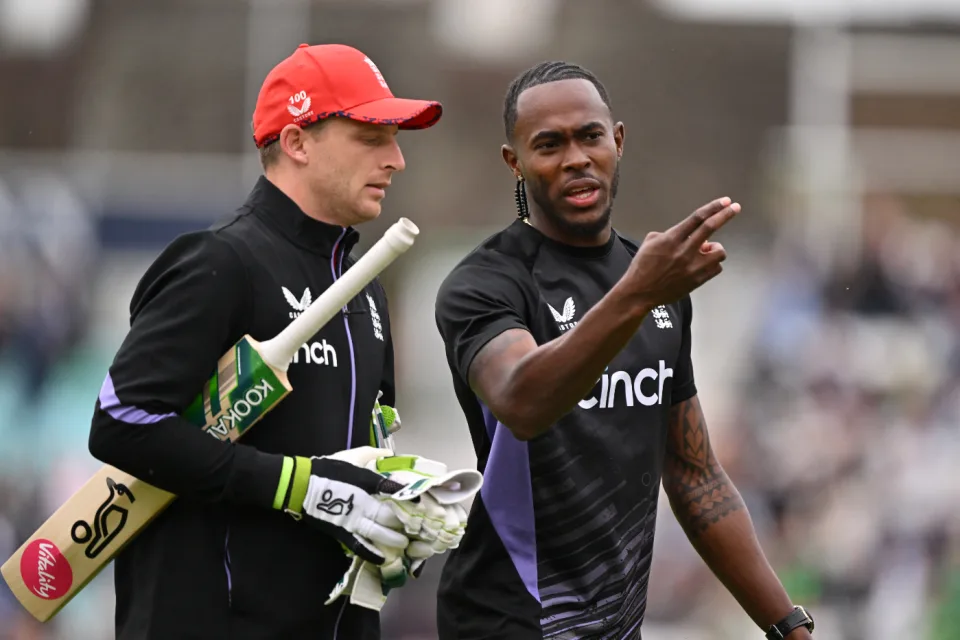
The first truly heavyweight clash of this expanded T20 World Cup format comes freighted with both history and subplots. A rematch of the 2010 World T20 final at Kensington Oval, the match pits Jos Buttler’s defending champions – who are aiming to become the first team to retain the trophy – against the Australian winning machine, victors at the 2021 edition and current world title-holders in Test and ODI cricket. And that’s before you throw in the Ashes for afters.
Already there is added pressure on England, after the rain in Bridgetown led to a share of the points in their opener against Scotland (and that having conceded 90 runs from 10 overs without taking a wicket in a tepid bowling display). Lose to their oldest rivals and it will leave their Super 8 prospects open to being waylaid by the perils of net run-rate calculations, or worse.
The Scotland match was the third abandonment in five suffered by England, after a rain-affected home series against Pakistan, which has clearly hampered their readiness for this campaign after almost six months without playing T20 together. It does not take much for a side to click in this format – and England looked in decent shape when they did get on the field against Pakistan – but Buttler will be anxious for things to go their way on Saturday, if only to avoid further questions referencing the team’s disastrous ODI World Cup defence last year.
Australia, under the laidback leadership of Mitchell Marsh would love nothing more than to add to the English sense of jeopardy – having helped bundle them out of the tournament in India on the way to taking the crown. Their head to head record is less impressive in T20 however, with England having won six of the last seven completed encounters, as well as that 2010 final.
Despite a wobble with the bat, Australia avoided mishap against Oman earlier in the week, the experience of David Warner and Marcus Stoinis shining through in difficult batting conditions. Surfaces in the Caribbean – not to mention those games staged in the USA – have already had teams scratching their heads; rather than the “slug-fest” England had prepared for, following a high-scoring tour of the Caribbean in December, it looks as if boxing smart may be the way to go.
Speaking of Warner, this could be the last time he faces up against England in national colours – and another match-winning contribution would likely reduce the chances of them meeting again in the knockouts. On the other side of the card is Jofra Archer, fresh from an emotional maiden outing at Kensington Oval and ready to take on Australia for the first time in any format since 2020. Can Mark Wood fire up England’s campaign, as he did during last summer’s Ashes? Will Pat Cummins be back to harass the old enemy once again? Seconds out, it’s almost time to rumble.
Cummins is set to return after being rested for the Oman game, which saw Mitchell Starc leave the field with cramp. Starc is understood to be fine and could keep his place – which would likely see Nathan Ellis miss out. Marsh is still not fit to bowl, with Australia likely to continue with the allrounder combination of Stoinis and Maxwell to give them cover.
Australia (probable XI): David Warner, Travis Head, Mitchell Marsh (capt), Glenn Maxwell, Marcus Stoinis, Josh Inglis (wk), Tim David, Pat Cummins, Nathan Ellis/Mitchell Starc, Adam Zampa, Josh Hazlewood
The one change England may consider is Reece Topley coming in for Wood, with the expectation that there will be some rotation among the seamers through the course of the tournament.
England (probable XI): Phil Salt, Jos Buttler (capt & wk), Will Jacks, Jonny Bairstow, Harry Brook, Liam Livingstone, Moeen Ali, Chris Jordan, Jofra Archer, Adil Rashid, Reece Topley/Mark Wood
[Cricinfo]
Sports
South Africa up against their bogey team in batter-unfriendly New York
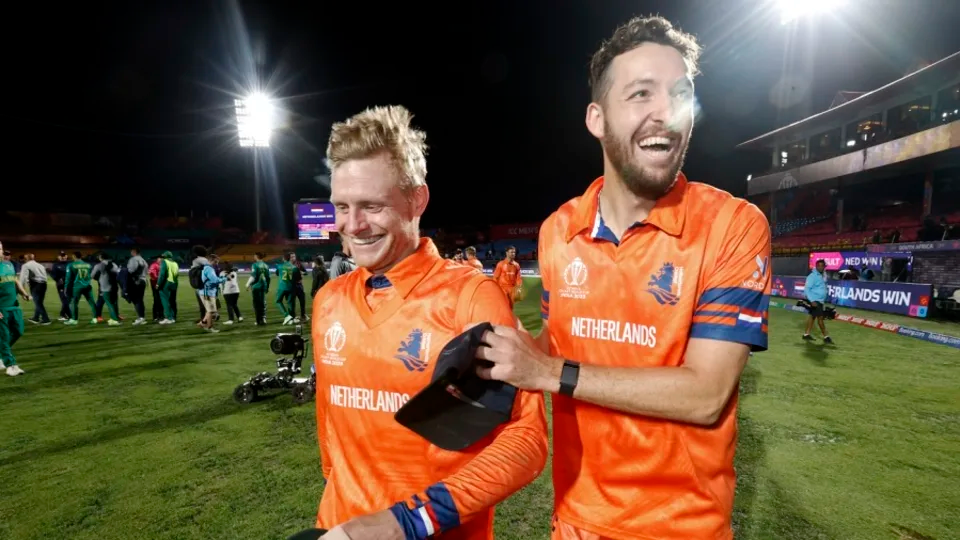
Once is coincidence, twice is a clue, and three times is proof.
To paraphrase Agatha Christie, that is the narrative around South Africa’s meeting with Netherlands at this T20 World Cup.
The Dutch beat South Africa at the 2022 tournament and ended their semi-final hopes in a match where South Africa appeared to be sleep walking, and then beat them again at the 2023 ODI World Cup, where they exposed South Africa’s vulnerability in the chase. If they to do the treble, not only will Netherlands take the lead in Group D, but they will offer conclusive evidence of the threat they pose to Full Members, especially South Africa.
Of course, it will take some doing after South Africa’s opening performance against Sri Lanka, where they reduced their opposition to their lowest T20I total and chased it down in fairly straightforward fashion thanks to the most stable middle-order of their white-ball era. In Aiden Markram, Tristan Stubbs, Heinrich Klaasen and David Miller, South Africa have bankers and big-hitters and, for this match, they also have the advantage of experience. They’ve already played at Eisenhower Park, and have first-hand knowledge that run-scoring doesn’t come easily;Klassen said they are prepared to use their “cricket brains” and play “smarter cricket”.
But the conditions could be good news for Netherlands, who are not naturally a line-up of big hitters and build their innings on a foundation of turning ones into twos. In other words, they tend to take a slightly more conservative approach to batting, which may work well here, but they’ll be wary of the uneven bounce of the surface and will have to come up with plans to counterattack especially against South Africa’s seamers. Their own bowlers were exemplary in Dallas and will look to build on that performance against a line-up that will likely be more proactive than Nepal’s, but who they have managed to keep quiet not once, but twice in the past. Third time’s the charm, they say.
Anrich Nortje’s stunning return to form against Sri Lanka means South Africa may not have to tinker with the bowling combination, and Gerald Coetzee and Tabraiz Shamsi may have to wait their turns to get a game. The batting line-up should be unchanged, with no space for Ryan Rickelton yet.
South Africa: Quinton de Kock (wk), Reeza Hendricks, Aiden Markam, Tristan Stubbs, Heinrich Klaasen (wk), David Miller, Marco Jansen, Keshav Maharaj, Kagiso Rabada, Ottneil Baartman, Anrich Nortje
Conditions in New York may tempt Netherlands to include an extra seamer and they have Kyle Klein in their squad. But it could come at the expense of a shortened batting line-up and they may not want to risk that.
Netherlands: Michael Levitt, Max O’Dowd, Vikramjit Singh, Sybrand Engelbrecht, Scott Edwards (capt, wk), Bas de Leede, Teja Nidamanuru, Logan van Beek, Tim Pringle, Paul van Meekeren, Vivian Kingma
[Cricinfo]
Latest News
Mustafizur, Rishad, Hridoy dazzle in Bangladesh’s tight two-wicket win over Sri Lanka
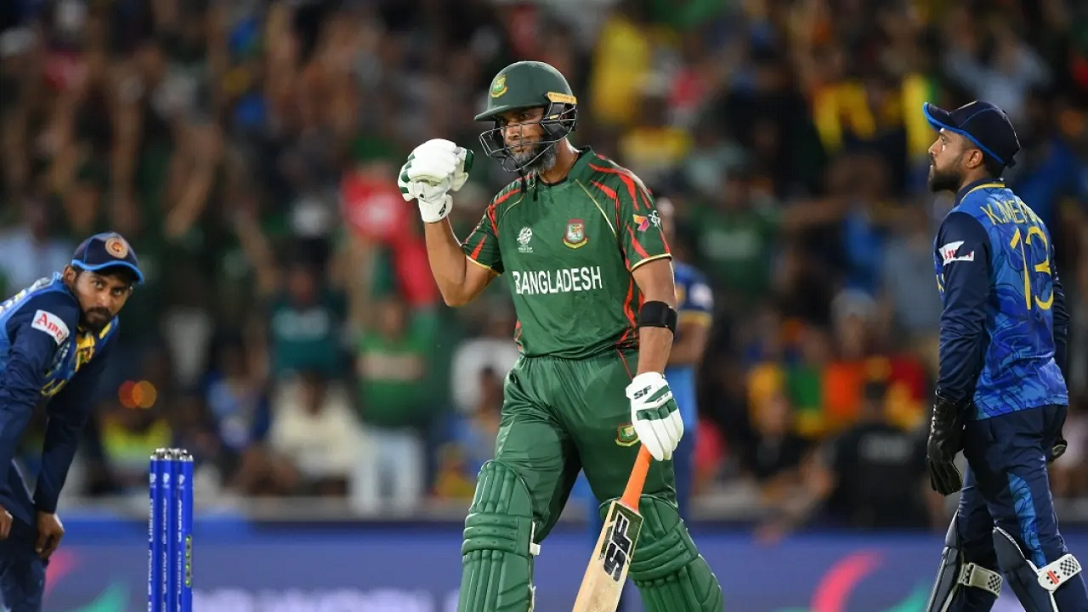
Nuwan Thushara’s last over brought Sri Lanka screaming back into the match,as he first bowled Rishad Hossain, and then nailed Taskin Ahmed in front of the stumps with a pinpoint swinging yorker. This left Bangladesh eight wickets down, with 12 runs still to get.
However, the experienced Mahmudullah was at the crease for Bangladesh, and despite some further nervy moments, pushed Bangladesh across the line off the last ball of the 19th over.
But this was a match chiefly decided by Bangladesh’s own outstanding bowling. Mustafizur Rahman was the best among them, using shorter lengths and his cutters efficiently, to claim figures of 3 for 17. Rishad Hossain’s three-for through the middle overs also kept Sri Lanka quiet.
Mustafizur was instrumental in Sri Lanka’s downward spiral through the middle overs, which culminated in a crash-and-burn end. Ultimately, their inability to find boundaries, or even rotate strike against good Bangladesh bowling resulted in their downfall. A score of 125 for 9 always seemed poor on a decent pitch, even if their bowlers made a match of it in the end.
Brief scores:
Bangladesh 125 for 8 in 19 overs (Towhid Hridoy 40, Litton Das 36; Dhanajaya de Silva 1-11, Nuwan Thushara 4-18, Wanidu Hasaranga 2-32, Matheesha Pathirana 1-27) beat Sri Lanka124 for 9 in 20 overs (Pathum Nissanka 47, Dhananjaya de Silva 21; Tanzim Hasan Sakib 1-24, Taskin Ahmed 2-25, Mustafizur Rahman 3-17, Rishad Hossain 3-22) by two wickets
[Cricinfo]












